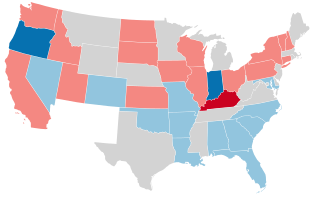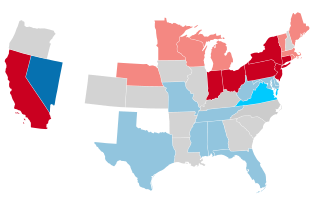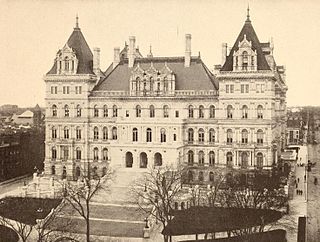
The 1908–09 United States Senate elections were held on various dates in various states. As these U.S. Senate elections were prior to the ratification of the Seventeenth Amendment in 1913, senators were primarily chosen by state legislatures. Senators were elected over a wide range of time throughout 1906 and 1907, and a seat may have been filled months late or remained vacant due to legislative deadlock. However, some states had already begun direct elections during this time. Oregon pioneered direct election and experimented with different measures over several years until it succeeded in 1907. Soon after, Nebraska followed suit and laid the foundation for other states to adopt measures reflecting the people's will. By 1912, as many as 29 states elected senators either as nominees of their party's primary or in conjunction with a general election.

The 1900 New York state election was held on November 6, 1900, to elect the governor, the lieutenant governor, the Secretary of State, the state comptroller, the attorney general, the state treasurer and the state engineer, as well as all members of the New York State Assembly and the New York State Senate.

The 1863 United States Senate election in New York was held on February 3, 1863, by the New York State Legislature to elect a U.S. Senator to represent the State of New York in the United States Senate.

The 1869 United States Senate election in New York was held on January 19, 1869, by the New York State Legislature. Incumbent Senator Edwin D. Morgan stood for a second term in office, but lost the support of the Republican legislative caucus in favor of Reuben Fenton.

The 1875 United States Senate election in New York was held on January 19 and 20, 1875, by the New York State Legislature. The legislature, with a Republican Senate and Democratic Assembly, jointly elected Democrat Francis Kernan Senator. Kernan became the first Democrat to represent New York since 1851.

The 1879 United States Senate election in New York was held on January 21, 1879, by the New York State Legislature to elect a U.S. Senator to represent the State of New York in the United States Senate.

The 1881 United States Senate election in New York was held on January 18, 1881, by the New York State Legislature to elect a U.S. Senator to represent the State of New York in the United States Senate.
The 1881 United States Senate special elections in New York was held from May 31 to July 22 by the New York State Legislature to elect two U.S. senators to represent New York in the United States Senate, following the joint resignations of Roscoe Conkling and Thomas C. Platt.
The 1887 United States Senate election in New York was held from January 18 to 20, 1887, by the New York State Legislature to elect a U.S. Senator to represent the State of New York in the United States Senate. Incumbent Republican Senator Warner Miller was not renominated by the Republican legislative caucus and was succeeded by Frank Hiscock.
The 1891 United States Senate election in New York was held on January 20 and 21, 1891, by the New York State Legislature to elect a U.S. Senator, to represent the State of New York in the United States Senate.
The 1893 United States Senate election in New York was held on January 17, 1893, by the New York State Legislature to elect a U.S. Senator to represent the State of New York in the United States Senate.

The 1897 United States Senate election in New York was held on January 19, 1897, by the New York State Legislature to elect a U.S. Senator to represent the State of New York in the United States Senate.

The 1899 United States Senate election in New York was held on January 17, 1899. Incumbent Democratic Senator Edward Murphy Jr. stood for re-election to a second term but was defeated by Republican Chauncey Depew. Republicans had maintained control of both houses of the legislature in the 1898 New York state election.

The 1909 United States Senate election in New York was held on January 19, 1909, by the New York State Legislature to elect a U.S. Senator to represent the State of New York in the United States Senate.
The 1911 United States Senate election in New York was held from January 17 to March 31, 1911, by the New York State Legislature to elect a U.S. Senator to represent the State of New York in the United States Senate.

The 1868–69 United States Senate elections were held on various dates in various states. As these U.S. Senate elections were prior to the ratification of the Seventeenth Amendment in 1913, senators were chosen by state legislatures. Senators were elected over a wide range of time throughout 1868 and 1869, and a seat may have been filled months late or remained vacant due to legislative deadlock. In these elections, terms were up for the senators in Class 1.

The 1874–75 United States Senate elections were held on various dates in various states. As these U.S. Senate elections were prior to the ratification of the Seventeenth Amendment in 1913, senators were chosen by state legislatures. Senators were elected over a wide range of time throughout 1874 and 1875, and a seat may have been filled months late or remained vacant due to legislative deadlock. In these elections, terms were up for the senators in Class 1.

The 1902–03 United States Senate elections were held on various dates in various states. As these U.S. Senate elections were prior to the ratification of the Seventeenth Amendment in 1913, senators were chosen by state legislatures. Senators were elected over a wide range of time throughout 1902 and 1903, and a seat may have been filled months late or remained vacant due to legislative deadlock. In these elections, terms were up for the senators in Class 3.

The 1880–81 United States Senate elections were held on various dates in various states, coinciding with the presidential election of 1880. As these U.S. Senate elections were prior to the ratification of the Seventeenth Amendment in 1913, senators were chosen by state legislatures. Senators were elected over a wide range of time throughout 1880 and 1881, and a seat may have been filled months late or remained vacant due to legislative deadlock. In these elections, terms were up for the senators in Class 1.

The 126th New York State Legislature, consisting of the New York State Senate and the New York State Assembly, met from January 7 to April 23, 1903, during the third year of Benjamin B. Odell Jr.'s governorship, in Albany.











